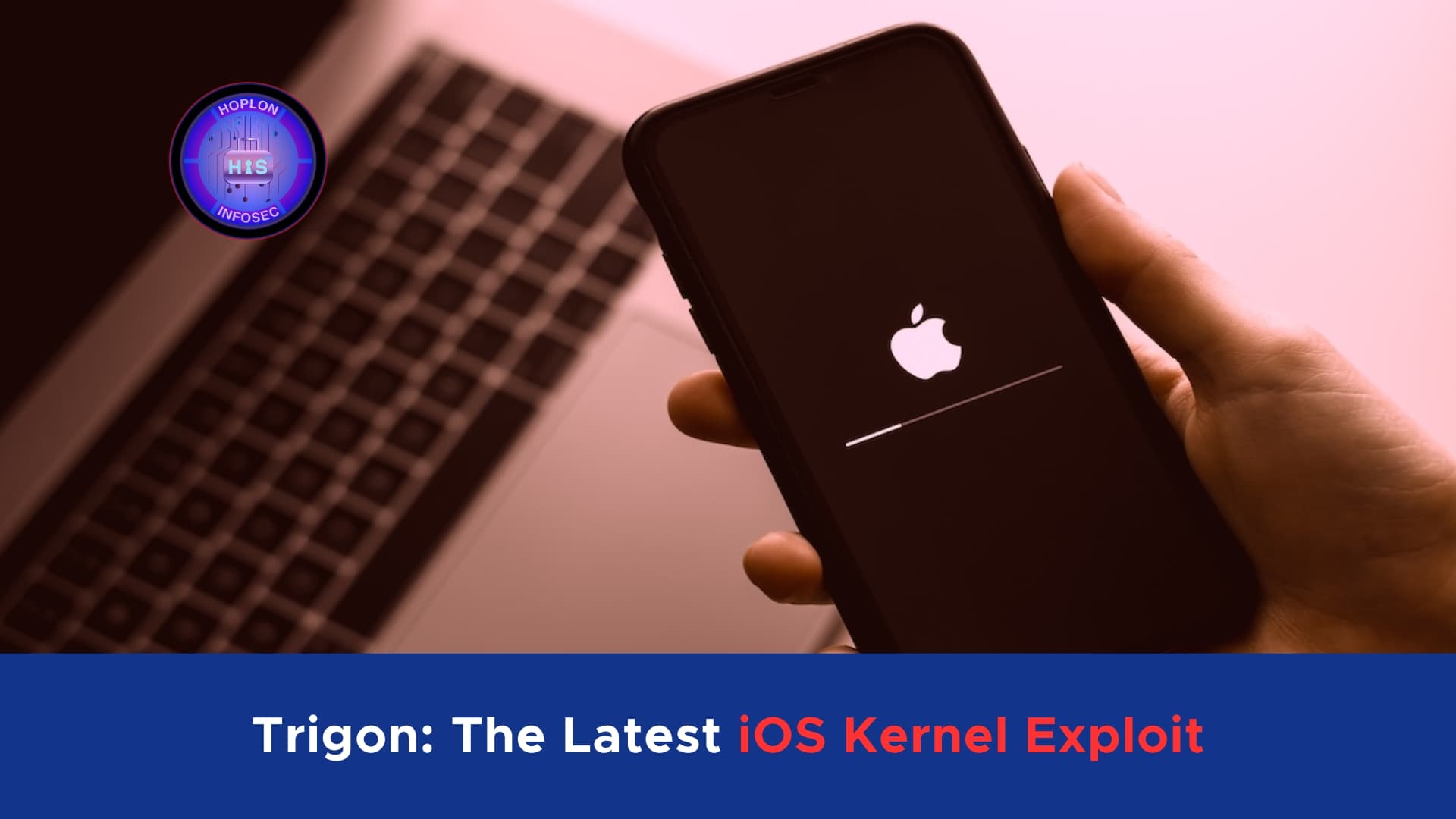Trigon: A Deep Dive into the Latest iOS Kernel Exploit

Hoplon InfoSec
03 Mar, 2025
In recent months, security researchers have introduced a sophisticated new kernel exploit targeting Apple iOS devices. Dubbed Trigon, this exploit takes advantage of a critical vulnerability within the XNU kernel’s virtual memory subsystem. This blog post provides an in-depth examination of Trigon, discussing its technical underpinnings, the stages of its exploitation chain, and the broader implications for iOS device security. In doing so, we aim to provide readers with a comprehensive understanding of how such vulnerabilities are discovered and weaponized, along with insights into current and future mitigation strategies.
Introduction to Kernel Exploits on iOS

Kernel exploits have long been a high-stakes area within the realm of cybersecurity. Unlike user-level vulnerabilities, kernel vulnerabilities provide attackers access to the most privileged parts of an operating system. A kernel exploit represents a severe threat in the context of iOS devices, which are known for their robust security architecture. Trigon exemplifies this threat by leveraging a vulnerability in the XNU kernel—the core of Apple’s operating system—to gain arbitrary read/write primitives within the kernel space. This level of access allows attackers to bypass traditional security measures without triggering the system’s built-in safeguards, such as kernel panics, making Trigon a uniquely dangerous tool.
Background: Understanding the XNU Kernel and Its Vulnerabilities
The XNU kernel is a hybrid kernel that combines elements of both microkernel and monolithic designs. It is the cornerstone of Apple’s operating systems, providing essential services such as memory management, process scheduling, and hardware abstraction. Due to its central role, any flaw within the XNU kernel can have far-reaching implications. One such flaw, identified as CVE-2023-32434, is an integer overflow vulnerability in the mach_make_memory_entry_64 function. Discovered in the wild during a sophisticated espionage effort known as Operation Triangulation, this vulnerability has provided threat actors with the means to create an oversized memory entry that far exceeds the physical limitations of the device.
The Discovery and Naming of Trigon
Trigon was not developed in isolation. Its discovery is linked with the notorious “Operation Triangulation” spyware campaign, which first weaponized the vulnerability uncovered by Kaspersky’s security team. Researchers working on this campaign found that attackers could create a memory entry that spans an astronomical 18,000 petabytes by exploiting this integer overflow. This dramatic over-allocation bypasses crucial sanity checks within the kernel, thus enabling kernel memory mapping into the user space. This capability is almost unheard of in modern iOS exploitation.
The exploit was developed by a team led by Alfie CG, with significant contributions from notable security researchers @staturnzz and @TheRealClarity. Its source code has been made publicly available on GitHub, providing both a learning resource and a potential tool for further exploitation if it falls into the wrong hands.
Detailed Technical Overview of Trigon
The Vulnerability: CVE-2023-32434
At the heart of Trigon lies an integer overflow in the mach_make_memory_entry_64 function. This function is responsible for creating memory entries that allow processes to interact with memory in a controlled manner. However, the vulnerability arises from an unchecked addition of user-controlled size and offset parameters. When supplied with crafted values—such as size=0xFFFFFFFFFFFFC000 and offset=0x8000—the function suffers an integer overflow. This overflow causes the function to miscalculate the boundaries of the memory entry, thereby allowing attackers to create an entry that is orders of magnitude larger than intended.
Exploitation Mechanics: A Three-Stage Process
Trigon’s exploitation chain is meticulously designed and executed in three distinct stages. Each stage is crucial in advancing the attacker’s control over the device.
Stage 1: Privileged Memory Entry Creation
The first stage involves creating a privileged memory entry within a unique region known as PurpleGfxMem. This memory region is typically reserved for GPU operations and is subject to less stringent internal flag checks than standard allocations. By crafting an IOSurface object with the IOSurfaceMemoryRegion property set to PurpleGfxMem, attackers can bypass the XNU kernel’s internal panic checks associated with memory page insertions. Essentially, this bypass allows for creating a parent memory entry that is not bound by the usual restrictions, laying the groundwork for subsequent exploitation.
Stage 2: Establishing a Physical Memory Mapping Primitive
Once the oversized memory entry is established, Trigon leverages it to map arbitrary physical addresses into the attacker’s process space. This is achieved via the mach_vm_map function, which is typically used to manage virtual memory mappings. A key aspect of this stage is the dynamic calculation of offsets relative to the boot-handoff region. The boot-handoff region is a data structure passed by the bootloader that resides in DRAM, and it contains critical information about the kernel slide and the boundaries of the Kernel Text Read-Only Region (KTRR).
On devices equipped with A10(X) chips, the process involves reading Memory-Mapped I/O (MMIO) registers that store the lower and upper limits of KTRR. By accurately reading these registers, the exploit can locate the kernel’s Mach-O header—a necessary step in establishing complete control over kernel memory.
Stage 3: Achieving Kernel Read/Write via IOSurface Spray
The final stage of Trigon’s exploitation involves bypassing the kernel’s Page Validation Hash (PVH) protections. This is accomplished by “spraying” thousands of IOSurface objects into the physical memory. IOSurface objects are commonly used to manage graphics buffers but can be manipulated in this context to achieve a kernel read/write primitive.
The exploit identifies non-page-table regions by scanning the pv_head_table, a kernel structure that tracks page types. Once these regions are identified, the attacker can manipulate the sprayed IOSurface objects to forge crucial structures, such as task_t and proc_t. These structures are central to process management and privilege escalation. By corrupting these structures, Trigon grants the attacker root privileges and turns off the sandboxing mechanisms fundamental to iOS security.
Platform Support and Limitations

Trigon is currently effective on A10(X)-based devices, which include models such as the iPhone 7 and the 6th generation iPad. These devices run iOS versions ranging from 13 up to 16.5.1. The exploit does not support newer Arm64e (A12+) or A11 system-on-chips (SoCs) devices. This exclusion is primarily due to several hardware-enforced mitigations present in newer models. These include:
- Pointer Authentication Codes (PAC): PACs serve as a cryptographic means to ensure the integrity of pointers, thereby preventing unauthorized modifications that could lead to kernel exploitation.
- Page Protection Layer (PPL) and Configurable TRR (CTRR): These mechanisms lock down kernel pages, making it substantially more difficult for attackers to map or read physical memory.
- Memory Mapping Restrictions: In newer devices, the boot-handoff region is deliberately placed outside mappable memory, hindering attempts to perform base calculations essential for the exploit’s success.
The deterministic nature of Trigon’s approach is particularly noteworthy. Unlike many other exploits that rely on memory corruption or race conditions, Trigon achieves its objectives without inducing kernel panics or corrupting memory. This precision presents a unique challenge to Apple’s security model, highlighting the evolving sophistication of modern exploitation techniques.
The Broader Security Implications
Impact on Jailbroken and Unpatched Devices
Although Apple has released a patch in iOS 16.5.1 to address the underlying vulnerability, the risks associated with Trigon persist, particularly for jailbroken devices and unpatched enterprise fleets. Jailbroken devices often operate with reduced security controls, making them an attractive target for sophisticated exploits like Trigon. Similarly, enterprise devices that have not yet received the latest security updates remain vulnerable to attacks that could leverage this exploit to gain elevated privileges and bypass security protocols.
Re-Evaluating Trust in Kernel Protections
Trigon’s successful exploitation of the XNU kernel forces security professionals to reexamine some long-held assumptions about iOS security. Mechanisms such as KTRR and CTRR were once considered robust barriers against kernel-level attacks. However, the existence of an exploit that can reliably bypass these protections indicates that additional layers of security integration—particularly at the System-on-chip (SoC) level—may be necessary. In essence, even systems deemed secure may harbor vulnerabilities that can be weaponized in unexpected ways.
The Role of Publicly Available Exploit Code
The public release of Trigon’s source code on GitHub adds another layer of complexity to the ongoing security landscape. On the one hand, the availability of such code can serve as a valuable resource for educational purposes and for furthering research into kernel exploitation. On the other hand, it raises concerns about the potential for misuse. The balance between transparency and security is delicate; while open-source initiatives can drive innovation, they also necessitate heightened vigilance from developers and end-users.
Mitigation Strategies and Future Directions
Software Updates and Patching
The most immediate and effective measure to counter exploits like Trigon is the prompt application of security patches. Apple’s release of an update to address CVE-2023-32434 in iOS 16.5.1 is a critical step in mitigating the risk. End-users are advised to keep their devices updated with the latest software releases. For enterprise environments, this means instituting strict policies to ensure that all devices receive updates promptly to reduce the window of vulnerability.
Strengthening Hardware-Enforced Security
For newer devices, hardware-level mitigations have proven to be a formidable barrier against exploitation. Enhancements such as Pointer Authentication Codes (PAC), the Page Protection Layer (PPL), and Configurable TRR (CTRR) are vital in preventing unauthorized access to kernel memory. Future hardware designs will likely continue to integrate even more sophisticated security features. These developments underscore the importance of designing systems with multiple, overlapping layers of defense—a strategy that can help mitigate the risk of even the most advanced kernel exploits.
The Need for SoC-Level MMU Policies
Trigon highlights a critical gap in current security practices: the need for more robust integration of Memory Management Unit (MMU) policies at the SoC level. In the case of Trigon, the ability to bypass kernel restrictions by exploiting unchecked arithmetic operations underscores the importance of comprehensive hardware and software integration. Future security measures must address these vulnerabilities by implementing stricter MMU policies that block physical mapping exploits before they can succeed.
Research and Continuous Vigilance
The rapid evolution of exploit techniques, as exemplified by Trigon, reinforces the need for continuous research and vigilance within the cybersecurity community. Security researchers must remain proactive, constantly testing and refining defensive strategies against emerging threats. In addition, collaborative efforts—such as those seen in the Operation Triangulation campaign—are essential for uncovering and understanding new vulnerabilities. The detailed analysis planned by the Kaspersky team, particularly regarding the arm64e-compatible exploitation chain, is a promising development that may yield further insights into how modern systems can be fortified against similar attacks.
Conclusion: The Future of iOS Security in a Changing Landscape

The discovery of Trigon represents a significant milestone in the ongoing battle between attackers and defenders in the cybersecurity domain. Through its sophisticated use of an integer overflow vulnerability in the XNU kernel, this kernel exploit has demonstrated that even well-established security mechanisms can be circumvented with the right combination of technical acumen and innovative exploitation techniques.
For end-users, the primary takeaway is maintaining up-to-date software on all devices. It is a stark reminder of the need to implement rigorous update policies and audit security postures for enterprises regularly. For researchers and developers, Trigon serves as both a challenge and an opportunity—a call to action to innovate and improve upon current security measures.
In an era where the lines between hardware and software vulnerabilities continue to blur, the lessons learned from Trigon will undoubtedly influence the next generation of security strategies. As new technologies emerge and the threat landscape evolves, so must the approaches to safeguarding our digital lives. The industry can stay one step ahead of attackers by embracing a holistic view of security that integrates robust hardware safeguards with agile software defenses.
Ultimately, while Trigon poses a serious threat to a subset of iOS devices, it also highlights the resilience and ingenuity of the cybersecurity community. The challenges presented by sophisticated kernel exploits can be met with equally innovative solutions through diligent research, continuous improvement, and collaborative efforts. The future of iOS security, though fraught with challenges, remains promising as experts worldwide work tirelessly to secure the digital ecosystem against the ever-evolving landscape of cyber threats.
With Trigon’s source code now publicly available, the onus is on the community and industry leaders to leverage this knowledge for defensive purposes. By turning potential vulnerabilities into opportunities for improvement, cybersecurity can continue to evolve, ensuring that user privacy and device integrity remain protected in an increasingly connected world.
As we look ahead, it is clear that the battle between attackers and defenders will persist. However, the risks posed by exploits like Trigon can be significantly mitigated through proactive measures, ongoing research, and a commitment to robust security practices. In this dynamic environment, staying informed, vigilant, and prepared is the best defense against emerging threats, ensuring our digital lives remain secure.
For more:
https://cybersecuritynews.com/ios-0-day-kernel-vulnerability/
Share this :